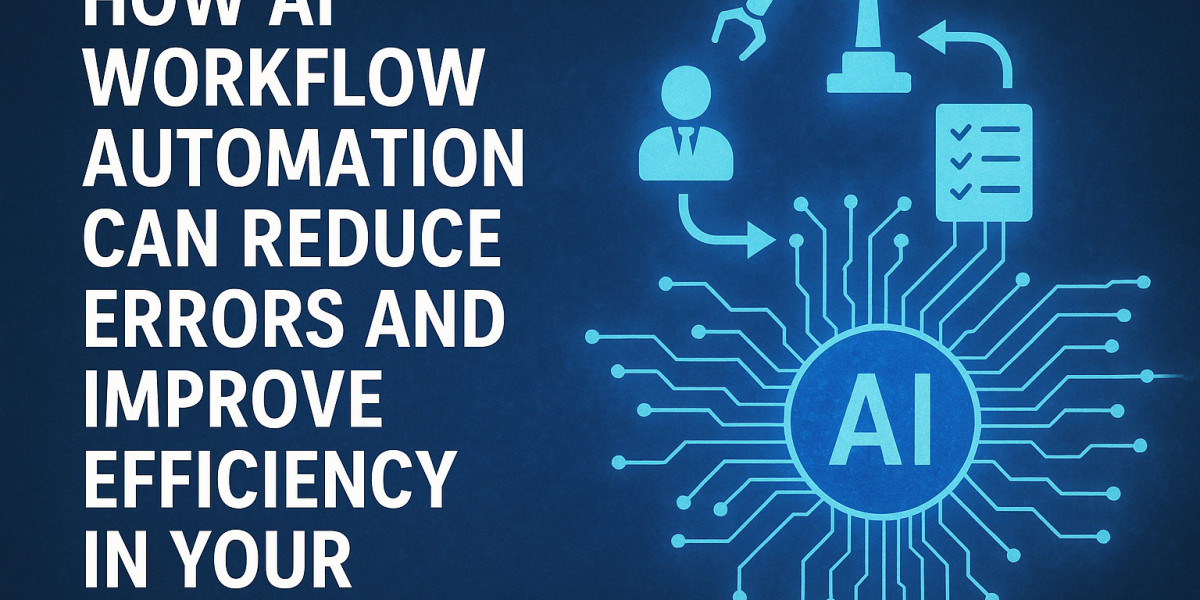Introduction: Why Workflow Automation Matters Today
Today’s businesses are under immense pressure to deliver faster results while maintaining accuracy across every touchpoint. Manual processes not only slow down workflows but also increase the chances of costly errors that can impact customer experience, compliance, and operational efficiency.
This is where Workflow Automation Services, powered by AI, come in, helping businesses automate repetitive, high-volume processes while ensuring consistent accuracy and speed. From reducing human errors to freeing up teams for strategic initiatives, AI workflow automation is not just a trend but a necessity for businesses aiming to remain competitive in a digital-first market.
Understanding AI Workflow Automation
AI workflow automation leverages machine learning, natural language processing, and robotic process automation (RPA) to replicate repetitive human tasks with improved efficiency and reduced errors. Unlike traditional automation, which can only handle rule-based processes, AI-powered automation can manage unstructured data, learn from patterns, and make decisions in real-time.
For example, where traditional automation might sort invoices by date, AI workflow automation can extract data from invoices with different formats, detect anomalies, and route them for approval, significantly reducing human intervention.
Common Business Errors AI Workflow Automation Can Eliminate
Manual processes often lead to:
- Data entry mistakes, such as incorrect values during invoice processing.
- Lost or misfiled documents during customer onboarding.
- Delayed or inaccurate customer responses due to manual ticket triaging.
- Inventory count discrepancies due to manual updates.
- Missed compliance deadlines because of oversight in reporting.
By adopting Workflow Automation Services, businesses can systematically eliminate these errors, ensuring data integrity and consistent operations.
How AI Workflow Automation Improves Efficiency
Accelerates Task Completion
AI-powered automation reduces process completion times from hours to minutes, ensuring that tasks such as invoice approvals or customer support queries are resolved promptly, improving customer satisfaction and operational agility.
Enhances Data Accuracy and Consistency
Errors are minimised as AI systems extract and process data accurately, maintaining uniformity across systems without manual intervention. For example, in HR operations, automated workflows can ensure accurate employee record updates across payroll, benefits, and compliance systems.
Frees Up Human Resources for Higher-Value Tasks
With repetitive tasks handled by AI, employees can focus on innovation, strategy, and customer engagement rather than spending time on mundane tasks. This shift boosts morale while unlocking opportunities for business growth.
Provides Real-Time Analytics for Continuous Improvement
AI workflow automation systems generate actionable insights, identifying bottlenecks and areas for improvement. Businesses can refine processes based on data, ensuring continuous optimisation of workflows.
Key Business Areas Where AI Workflow Automation Adds Value
Finance and Accounting
AI automates invoice data extraction, expense claim processing, and reconciliation tasks, ensuring accurate financial records and faster month-end closings.
Human Resources
From automating onboarding workflows to managing leave requests and updating employee records, HR teams can improve employee experiences while reducing administrative overhead.
Customer Support
AI chatbots and automated ticket routing enable prompt responses, reducing wait times and ensuring customer queries are resolved accurately.
Supply Chain Management
AI automation optimises inventory tracking, demand forecasting, and order management, reducing stockouts and excess inventory.
Sales and Marketing
AI can automate lead qualification, personalised email campaigns, and follow-ups, enabling marketing teams to focus on strategy while improving campaign efficiency.
Steps to Implement AI Workflow Automation in Your Business
Identify Processes for Automation: Begin by mapping workflows and identifying repetitive, error-prone tasks suitable for automation.
Select the Right Workflow Automation Services: Choose providers who understand your business needs and can integrate AI-powered tools seamlessly with your existing infrastructure.
Start Small with Pilot Projects: Test automation in a specific department to measure impact and gather insights before scaling.
Train Teams for Adoption: Prepare your teams to work alongside AI systems, emphasising collaboration between human expertise and automation.
Monitor, Measure, and Optimise: Continuously track KPIs such as processing times, error rates, and cost savings to refine workflows further.
Overcoming Challenges in AI Workflow Automation
While the benefits are compelling, businesses may face challenges like:
- Integrating AI automation with legacy systems.
- Ensuring high-quality data for effective AI functioning.
- Managing employee concerns regarding role shifts post-automation.
- Maintaining data security and compliance during automation transitions.
Partnering with the right Workflow Automation Services provider helps address these challenges effectively, ensuring a smooth transition.
Measuring Success: KPIs to Track Post-Automation
To assess the effectiveness of AI workflow automation:
- Track reductions in manual errors and rework rates.
- Monitor improvements in process completion times.
- Evaluate cost savings across automated workflows.
- Analyse improvements in customer satisfaction scores.
- Measure the reallocation of employee time to strategic tasks.
Future Trends in AI Workflow Automation
The landscape of AI workflow automation continues to evolve:
- Hyperautomation combines AI, RPA, and low-code tools for end-to-end process automation.
- Intelligent Document Processing to handle unstructured data.
- Integration with IoT devices for real-time supply chain actions.
- Advanced conversational AI for human-like customer interactions.
Businesses investing in these trends will gain a significant competitive edge, further enhancing operational efficiency while reducing errors across workflows.
Conclusion: Transform Your Business with AI Workflow Automation
AI workflow automation is not merely a tool for operational efficiency; it is a strategic asset for reducing errors, improving accuracy, and accelerating business growth. By leveraging Workflow Automation Services, businesses can prepare for the future, enhance customer experiences, and free up valuable resources for innovation.
Now is the time to evaluate your business processes, identify areas suitable for automation, and embark on the journey toward a more efficient, error-free, and scalable future with AI workflow automation.






